Health
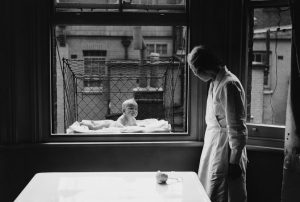 For a long time, people in the 19th century, living in urban apartments, didn’t regularly take their children outside so they could get some fresh air. Then, the doctors started to recommend that these children really needed to get outside for fresh air. Now that doesn’t necessarily mean that the parents were real excited about the idea of loading up their child and taking them for a walk…just to get the recommended amount of fresh air. Nevertheless, it was important, as the doctors told them that it would strengthen their immune system, and with the number of pandemics that had gone around, the parents really tried to do whatever they could to make this happen.
For a long time, people in the 19th century, living in urban apartments, didn’t regularly take their children outside so they could get some fresh air. Then, the doctors started to recommend that these children really needed to get outside for fresh air. Now that doesn’t necessarily mean that the parents were real excited about the idea of loading up their child and taking them for a walk…just to get the recommended amount of fresh air. Nevertheless, it was important, as the doctors told them that it would strengthen their immune system, and with the number of pandemics that had gone around, the parents really tried to do whatever they could to make this happen.
While physicians such as Dr. Luther Emmett Holt advised simply placing an infant’s basket near an open window, some parents took it a step further. Enter the Baby Cage. The baby cage was just what it sounded like. It was a platform, with chicken wire all around it to keep the baby in. This whole contraption was then suspended outside the window…even if the window was on the sixth floor or something. 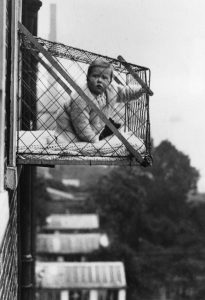 Personally, I can’t imagine hanging my baby outside my window for a dose of fresh air, but it was an actual thing in those days.
Personally, I can’t imagine hanging my baby outside my window for a dose of fresh air, but it was an actual thing in those days.
Eleanor Roosevelt, who by her own admission “knew absolutely nothing about handling or feeding a baby,” bought a chicken-wire cage after the birth of her daughter, Anna. She hung it out the window of her New York City apartment and placed Anna inside for her naps…until a concerned neighbor threatened to report her to the authorities. I would think so. If the brackets that suspended the cage to the window came loose…so long baby. I couldn’t find any incidence of such a thing happening, however. The first commercial patent for a baby cage was filed in 1922 by Emma Read of Spokane, Washington. The cages became popular in London in the 1930s among apartment dwellers without access to backyards. Ultimately, their popularity declined. It is possible that this was connected to safety concerns. As I said, I can imagine. I would have nightmares about that if it were my child.
 Whenever we make a trip to the emergency room, most of us find ourselves waiting impatiently for the myriad of tests to be returned from the lab to find out what is going on. And, most of us find that annoying, but when you think about how things used to be diagnosed, you might just find yourself rethinking those tests. Imagine a time when something like Pneumonia, Bronchitis, or Tuberculosis might have been “diagnosed” by having you doctor place his ear to your chest to see what you sound like. While I’m no expert, I have a pretty good idea that those three lung diseases would sound fairly similar. So if you had Tuberculosis and your doctor treated you for Bronchitis, how good would you expect your prognosis to be. Not very good, but this was all the doctor could do at that time.
Whenever we make a trip to the emergency room, most of us find ourselves waiting impatiently for the myriad of tests to be returned from the lab to find out what is going on. And, most of us find that annoying, but when you think about how things used to be diagnosed, you might just find yourself rethinking those tests. Imagine a time when something like Pneumonia, Bronchitis, or Tuberculosis might have been “diagnosed” by having you doctor place his ear to your chest to see what you sound like. While I’m no expert, I have a pretty good idea that those three lung diseases would sound fairly similar. So if you had Tuberculosis and your doctor treated you for Bronchitis, how good would you expect your prognosis to be. Not very good, but this was all the doctor could do at that time.
Enter René Théophile Hyacinthe Laennec (February 17, 1781 – August 13, 1826), a young man who’s mother died of tuberculosis when he was five years old. Laennec went to live with his great uncle the Abbé Laennec, who was a priest. As a child, Laennec became ill with Lassitude and repeated instances of Pyrexia. Laennec was also thought to have Asthma. At the age of twelve, he proceeded to Nantes, where his uncle, Guillaime-François Laennec, worked in the faculty of medicine at the university. Laennec was a gifted student. He learned English and German and began his medical studies under his uncle’s direction. Laennec knew first hand that 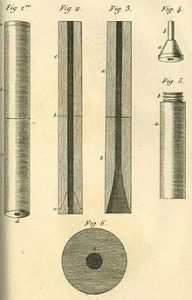 things like Tuberculosis can kill…he lived that nightmare with his mom. I am fairly certain that there were probably issues with her diagnosis too. After studying medicine, Laennec became a doctor. He also became a lecturer at the Collège de France in 1822 and professor of medicine in 1823. His final appointments were that of head of the medical clinic at the Hôpital de la Charité and professor at the Collège de France.
things like Tuberculosis can kill…he lived that nightmare with his mom. I am fairly certain that there were probably issues with her diagnosis too. After studying medicine, Laennec became a doctor. He also became a lecturer at the Collège de France in 1822 and professor of medicine in 1823. His final appointments were that of head of the medical clinic at the Hôpital de la Charité and professor at the Collège de France.
Laennec’s father was a lawyer, and he thought that being a doctor was a waste of René’s talents. With his father’s discouragement, René had a period of time during which he took long walks in the country, danced, studied Greek and wrote poetry. However, in 1799 he returned to study. Laennec studied medicine at the University of Paris under several famous physicians, including Dupuytren and Jean-Nicolas Corvisart-Desmarets. There he was trained to use sound as a diagnostic aid. Corvisart advocated the re-introduction of percussion during the French Revolution. In 1816, he was consulted by a young woman laboring under general symptoms of diseased heart, and in whose case percussion and the application of the hand were of little avail on account of the great degree of fatness. “The other method just mentioned [direct auscultation] being rendered inadmissible by the age and sex of the patient, I happened to recollect a simple and well-known fact, in acoustics…the great distinctness with which we hear the scratch of a pin at one end of a piece of wood on 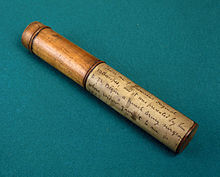 applying our ear to the other. Immediately, on this suggestion, I rolled a quire of paper into a kind of cylinder and applied one end of it to the region of the heart and the other to my ear, and was not a little surprised and pleased to find that I could thereby perceive the action of the heart in a manner much more clear and distinct than I had ever been able to do by the immediate application of my ear.” This situation started Laennec’s mind whirling, and before long, he had developed a simplistic version of what we now are all very familiar…the stethoscope. Ironically, like his mother, Laennec died of Tuberculosis on August 13, 1826. While I’m sure medicine had vastly improved during his lifetime, there was still no significant help for Tuberculosis.
applying our ear to the other. Immediately, on this suggestion, I rolled a quire of paper into a kind of cylinder and applied one end of it to the region of the heart and the other to my ear, and was not a little surprised and pleased to find that I could thereby perceive the action of the heart in a manner much more clear and distinct than I had ever been able to do by the immediate application of my ear.” This situation started Laennec’s mind whirling, and before long, he had developed a simplistic version of what we now are all very familiar…the stethoscope. Ironically, like his mother, Laennec died of Tuberculosis on August 13, 1826. While I’m sure medicine had vastly improved during his lifetime, there was still no significant help for Tuberculosis.
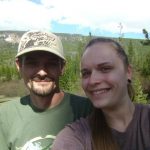 For my nephew, Chris Iverson and my niece, Cassie Iverson, life has not always been easy. The birth of their oldest child, Lucas, born with Down’s Syndrome brought the beginning of a host of future medical bills, but anyone who knows Lucas can tell you that he is just the sweetest boy. His parents and family wouldn’t trade him for the world. Nor would his little sister, Zoey, who loves him to pieces, and inspires him to progress. Chris homeschools the kids, and lately he has been trying to incorporate some extra work with Lucas, because he is, of course behind other children his age, but he has the added handicap of ongoing medical treatments that have plagued him for a while now. Zoey is two and a half now, so she is at just the right age for starting pre-school, so Chris is starting with her ABCs now.
For my nephew, Chris Iverson and my niece, Cassie Iverson, life has not always been easy. The birth of their oldest child, Lucas, born with Down’s Syndrome brought the beginning of a host of future medical bills, but anyone who knows Lucas can tell you that he is just the sweetest boy. His parents and family wouldn’t trade him for the world. Nor would his little sister, Zoey, who loves him to pieces, and inspires him to progress. Chris homeschools the kids, and lately he has been trying to incorporate some extra work with Lucas, because he is, of course behind other children his age, but he has the added handicap of ongoing medical treatments that have plagued him for a while now. Zoey is two and a half now, so she is at just the right age for starting pre-school, so Chris is starting with her ABCs now.
In his spare time…when he can’t go fishing much…Chris is into video games, especially the online gaming. The 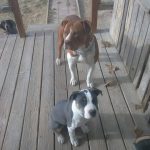 competition makes it much more fun than just going against the computer. Right now he is into Horizon Zero Dawn. Now, I can’t begin to tell you what these games are all about, but I would assume some kind of fighting game. Chris has also been training the family dogs, He wants to get them well behaved before too much longer, since they are already no longer puppies. Life for the Iverson family has had its ups, and its downs, but now there is a light at the end of the tunnel. Unfortunately, it too will come with its share of sadness.
competition makes it much more fun than just going against the computer. Right now he is into Horizon Zero Dawn. Now, I can’t begin to tell you what these games are all about, but I would assume some kind of fighting game. Chris has also been training the family dogs, He wants to get them well behaved before too much longer, since they are already no longer puppies. Life for the Iverson family has had its ups, and its downs, but now there is a light at the end of the tunnel. Unfortunately, it too will come with its share of sadness.
Chris and Cassie are currently planning a move to Tennessee. It’s not that they don’t love Powell, Wyoming, because they do. Powell has been their home for many years, if not all their lives, but with the medical needs of their son, and the opportunity for both of them to get an education and improve their lifestyle, they need to be in a more populated area that has  more to offer their special needs son. They have looked elsewhere, but there is nothing out there that is in Wyoming or even the surrounding states, so the move was inevitable. I know that their whole family will really miss them. It is always sad when your kids move away, but if it is the best thing for them, you have to simply let them go. I know that with Facebook, Skype, texting, and phone calls, they can stay close, and visits to Tennessee wouldn’t be the worst thing either. As for education, Chris plans to go to trade school to become a Plumber, and Cassie is planning to become a Real Estate agent…both occupations that will pay well, and provide for their family. While we will miss them, we also wish them the very best. Today is Chris’ birthday. Happy birthday Chris!! Have a great day!! We love you!!
more to offer their special needs son. They have looked elsewhere, but there is nothing out there that is in Wyoming or even the surrounding states, so the move was inevitable. I know that their whole family will really miss them. It is always sad when your kids move away, but if it is the best thing for them, you have to simply let them go. I know that with Facebook, Skype, texting, and phone calls, they can stay close, and visits to Tennessee wouldn’t be the worst thing either. As for education, Chris plans to go to trade school to become a Plumber, and Cassie is planning to become a Real Estate agent…both occupations that will pay well, and provide for their family. While we will miss them, we also wish them the very best. Today is Chris’ birthday. Happy birthday Chris!! Have a great day!! We love you!!
 Unfortunately, these days, school shootings, while shocking every time, are not totally uncommon in this country. The reasons for the shootings vary, but are often blamed on bullying, loneliness, or anger for perceived wrongs. They never solve anything, least of all for the shooter, who is usually dead, or in prison after the heinous deed is done. The rest of the world is left wondering why, and how we can fix this. Of course, there are always the anti-gun advocates who say that the only solution is to take the guns out of the hands of the citizens, but as most sensible people know, guns don’t kill people, people kill people.
Unfortunately, these days, school shootings, while shocking every time, are not totally uncommon in this country. The reasons for the shootings vary, but are often blamed on bullying, loneliness, or anger for perceived wrongs. They never solve anything, least of all for the shooter, who is usually dead, or in prison after the heinous deed is done. The rest of the world is left wondering why, and how we can fix this. Of course, there are always the anti-gun advocates who say that the only solution is to take the guns out of the hands of the citizens, but as most sensible people know, guns don’t kill people, people kill people.
In 1979, I was a busy, young mother, when the first school shooting took place. The date was January 29, 1979. The place was Grover Cleveland Elementary School in San Diego, California. The shooter was 16 year old Brenda Spencer. I have to assume that she is some relation to me, as researchers have claimed that all the Spencers in the United States are related. That thought in itself makes me sad. People have the potential to become such great things, and there are so many wonderful things that a person could be the first to accomplish. So, why on that day, did young Brenda Spencer decide to take the lives of to men and wound nine children at the school across the street from her home. Her stated reasons were several…”I like red jackets,” “It livens up the day,” “I had no reason for it, and it was just fun,” “It was like shooting ducks in a pond,” “The children looked like a herd of cows standing around,” “It was really easy pickings,” And the one that stuck with the crime forever, “I just don’t like Mondays.” There is no good reason to decide to go out and kill people, but that last one stuck in my head. She didn’t like Mondays, so she ruined her own life, killed 2 men and wounded 9 children!!
Of course, I doubt if Mondays, red jackets, boredom, or animals had anything to do with it. In my opinion, the cause is mental illness. I’m not excusing her actions, because murder is a heinous crime. Brenda did not just wake up that day and decide to shoot up the school. She was a problem child, who was widely known as a drug abuser with a violent streak, such as repeatedly shooting BBs at the windows of the school. Still, her father gave her a .22 semi-automatic rifle and ammunition as a Christmas gift at the end of 1978. I’m sure he thought that her BB shooting was a harmless prank, but with the drugs and anger simmering inside her, he was wrong. She had started telling her classmates that she was going to do something “to get on TV.”
That January morning, as the children were entering the school, Brenda Spencer blazed away with rifle shots  from her home directly across the street from the school. After 20 minutes of shooting, police surrounded Spencer’s home for six hours before she surrendered. Brenda Spencer had become the first person to commit a school shooting. Asked for some explanation for the attack, she simply said, “I just don’t like Mondays. I did this because it’s a way to cheer up the day. Nobody likes Mondays.” Spencer’s hatred for the first day of the school week was later memorialized by Bob Geldof, the leader of the rock group The Boomtown Rats, in the song, “I Don’t Like Mondays.” Spencer, who pled guilty to two counts of murder and assault with a deadly weapon, is currently serving a term of 25 years to life at the California Institution for Women in Corona, California, and she was denied parole four times, most recently in 2005.
from her home directly across the street from the school. After 20 minutes of shooting, police surrounded Spencer’s home for six hours before she surrendered. Brenda Spencer had become the first person to commit a school shooting. Asked for some explanation for the attack, she simply said, “I just don’t like Mondays. I did this because it’s a way to cheer up the day. Nobody likes Mondays.” Spencer’s hatred for the first day of the school week was later memorialized by Bob Geldof, the leader of the rock group The Boomtown Rats, in the song, “I Don’t Like Mondays.” Spencer, who pled guilty to two counts of murder and assault with a deadly weapon, is currently serving a term of 25 years to life at the California Institution for Women in Corona, California, and she was denied parole four times, most recently in 2005.

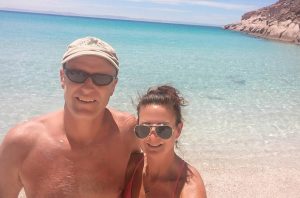 My niece, Toni Chase has become a world traveler since her marriage to Dave. She and Dave love going places. Whether it’s Hawaii, or the Caribbean, they spend as much time traveling as they can. They decided to get a time share, and while most people who have a time share, end up selling it because they don’t really use it, that is not the case with Toni and Dave. They love theirs and they use it often. They just pick a date, and look and the available sites, and register for their dates. If a person thinks they like to travel, but really isn’t sure, time shares are probably not the best thing to have, but for Toni and Dave, it was perfect, and they use it a lot. in fact, they went to Mexico in June.
My niece, Toni Chase has become a world traveler since her marriage to Dave. She and Dave love going places. Whether it’s Hawaii, or the Caribbean, they spend as much time traveling as they can. They decided to get a time share, and while most people who have a time share, end up selling it because they don’t really use it, that is not the case with Toni and Dave. They love theirs and they use it often. They just pick a date, and look and the available sites, and register for their dates. If a person thinks they like to travel, but really isn’t sure, time shares are probably not the best thing to have, but for Toni and Dave, it was perfect, and they use it a lot. in fact, they went to Mexico in June.
For Toni, family comes first. Her boys are the most important part of her life. She had a son, James Renville from her first marriage, and while Dave loves James, and is a big part of his life, he would never try to replace James’ real dad. I think it is the respect shown on both sides of that split, that has made it a very good relationship for all of them. Of course, a good relationship between blended families is only possible if everyone works together, and for this group the respect, cooperation, and a genuine love for James. And isn’t that really what good parents do…the best thing for the kids.
This has been an interesting year for Toni. Dave has spent much of his time playing softball and basketball, and 
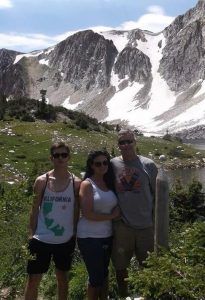 apparently that’s a little hard on Toni. I don’t know if it was heavy duty cheering, or what, but Toni ended up having hernia surgery. During the surgery, they found that the appendix was caught in the hernia, and it had to be removed too. It wasn’t Dave’s sports that caused Toni’s need for surgery, but Toni is a great cheerleader when it come to the sports and activities of her boys. I think she pretty much likes anything they are doing. Of course when it comes to what Toni is doing, Dave like most husbands, Dave couldn’t tell you what she has been up to. Toni has recently become interested in Wyoming history. Maybe she is a chip off of her Aunt Caryn’s block. She says that it’s very addictive. I agree. Today is Toni’s birthday. Happy birthday Toni!! Have a great day!! We love you!!
apparently that’s a little hard on Toni. I don’t know if it was heavy duty cheering, or what, but Toni ended up having hernia surgery. During the surgery, they found that the appendix was caught in the hernia, and it had to be removed too. It wasn’t Dave’s sports that caused Toni’s need for surgery, but Toni is a great cheerleader when it come to the sports and activities of her boys. I think she pretty much likes anything they are doing. Of course when it comes to what Toni is doing, Dave like most husbands, Dave couldn’t tell you what she has been up to. Toni has recently become interested in Wyoming history. Maybe she is a chip off of her Aunt Caryn’s block. She says that it’s very addictive. I agree. Today is Toni’s birthday. Happy birthday Toni!! Have a great day!! We love you!!
 The Vietnam war was many things, but I don’t think anyone really expected Operation Ranch Hand…at least not the general public. Who would have expected such a heinous act to be carried out by the government. Operation Ranch Hand was a United States military operation during the Vietnam War, lasting from 1962 until 1971. The operation was largely inspired by the British use of 2,4,5-T and 2,4-D (Agent Orange) during the Malayan Emergency in the 1950s. It was part of the overall program during the war called “Operation Trail Dust.” Ranch Hand involved spraying an estimated 20 million United States gallons of defoliants and herbicides over rural areas of South Vietnam in an attempt to deprive the Viet Cong of food and vegetation cover. Nearly 20,000 sorties were flown between 1961 and 1971.
The Vietnam war was many things, but I don’t think anyone really expected Operation Ranch Hand…at least not the general public. Who would have expected such a heinous act to be carried out by the government. Operation Ranch Hand was a United States military operation during the Vietnam War, lasting from 1962 until 1971. The operation was largely inspired by the British use of 2,4,5-T and 2,4-D (Agent Orange) during the Malayan Emergency in the 1950s. It was part of the overall program during the war called “Operation Trail Dust.” Ranch Hand involved spraying an estimated 20 million United States gallons of defoliants and herbicides over rural areas of South Vietnam in an attempt to deprive the Viet Cong of food and vegetation cover. Nearly 20,000 sorties were flown between 1961 and 1971.
It’s hard to say if the government knew the consequences of the chemicals that were used. It’s possible that the chemicals were thought to just kill vegetation, and not to hurt people. The people involved were known as 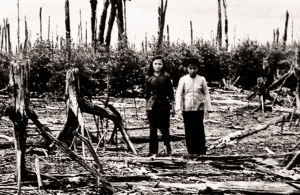 Ranch Handers. I seriously doubt that at some point they didn’t wonder if what they were doing could possibly be harmful to the people they were spraying it on or near. Nevertheless, the “Ranch Handers” had a motto, “Only you can prevent a forest.” It was a take on the popular United States Forest Service poster slogan of Smokey Bear. During the ten years of spraying, over 5 million acres of forest and 500,000 acres of crops were heavily damaged or destroyed. Around 20% of the forests of South Vietnam were sprayed at least once.
Ranch Handers. I seriously doubt that at some point they didn’t wonder if what they were doing could possibly be harmful to the people they were spraying it on or near. Nevertheless, the “Ranch Handers” had a motto, “Only you can prevent a forest.” It was a take on the popular United States Forest Service poster slogan of Smokey Bear. During the ten years of spraying, over 5 million acres of forest and 500,000 acres of crops were heavily damaged or destroyed. Around 20% of the forests of South Vietnam were sprayed at least once.
The herbicides were sprayed by the United States Air Force flying C-123s using the call sign “Hades.” The planes were fitted with specially developed spray tanks with a capacity of 1,000 United States gallons of herbicides. A plane sprayed a swath of land that was ½ mile wide and 10 miles long in about 4½ minutes, at a rate of about 3 United States gallons per acre. Sorties usually consisted of three to five airplanes flying side by 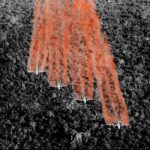 side, and 95% of the herbicides and defoliants used in the war were sprayed by the United States Air Force as part of Operation Ranch Hand. The remaining 5% were sprayed by the United States Chemical Corps, other military branches, and the Republic of Vietnam using hand sprayers, spray trucks, helicopters and boats, primarily around United States military installations…meaning that the majority of the chemicals were exposed to the Untied States Military. Many of the Vietnam veterans have felt betrayed by their own government. Many have felt that the government was well aware of the dangers of the chemicals they were spraying. I don’t know if they knew or not, but it seems like they should have suspected something. Years later, the effects of Agent Orange are well known and it was vicious.
side, and 95% of the herbicides and defoliants used in the war were sprayed by the United States Air Force as part of Operation Ranch Hand. The remaining 5% were sprayed by the United States Chemical Corps, other military branches, and the Republic of Vietnam using hand sprayers, spray trucks, helicopters and boats, primarily around United States military installations…meaning that the majority of the chemicals were exposed to the Untied States Military. Many of the Vietnam veterans have felt betrayed by their own government. Many have felt that the government was well aware of the dangers of the chemicals they were spraying. I don’t know if they knew or not, but it seems like they should have suspected something. Years later, the effects of Agent Orange are well known and it was vicious.
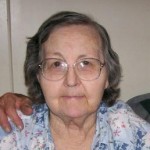
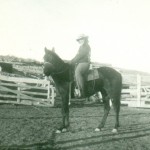 My mother-in-law, Joann Schulenberg has always been a tough lady, and I suppose that is why we found it so hard to believe that she would not win this final battle in her life. She bounced back so many times, when we all thought she was going for sure, but in the end, it was not the things we expected to take her life, like COPD or diabetes, that actually did so, but rather kidney failure, complicated by congestive heart failure. Through all of the many episodes of illness in her life, we were amazed at the strength she displayed while fighting her way back to where she had been before getting sick. This final battle would be different. She was tired, and she was ready to go home to Heaven. And while we were very sad and hated to let her go, we could not ask her to stay. She had suffered long enough.
My mother-in-law, Joann Schulenberg has always been a tough lady, and I suppose that is why we found it so hard to believe that she would not win this final battle in her life. She bounced back so many times, when we all thought she was going for sure, but in the end, it was not the things we expected to take her life, like COPD or diabetes, that actually did so, but rather kidney failure, complicated by congestive heart failure. Through all of the many episodes of illness in her life, we were amazed at the strength she displayed while fighting her way back to where she had been before getting sick. This final battle would be different. She was tired, and she was ready to go home to Heaven. And while we were very sad and hated to let her go, we could not ask her to stay. She had suffered long enough.
Throughout the years that Joann was my mother-in-law, she was an inspiration to many people. She had the ability to do so many things…knitting, crocheting, sewing, canning, and oh, her baking!! Mom could make a “Murder Cake” that could easily destroy any diet, because it was irresistible. “Murder Cake” was a chocolate cake with so much gooey, yummy fudge that the frosting became a part of the gooey cake. Maybe it was called “Murder Cake” because it murdered your diet. It was also my mother-in-law who introduced me to Squash and Pancakes, a dish that sounds like it should be awful, but one bite, and you are hooked. My husband, Bob; daughter, Amy; and I look forward to summer just for the squash and pancakes.
Having been raised in the country or small towns, the country was where Joann felt mostly at home. It was where she raised her children, and where one of them still lives today. She felt like it was easier to keep track of all those kids, if she had them out in the country, and when the family lived in Mills while the older children were in grade school, she finally told my father-in-law, Walt, that he needed to get the family back out in the country. And so he did. For the first 23 years of my marriage into the family, that is where they lived, and then because of health issues, they made a trade for a house in Casper…right on one of the busiest intersections in town…13th and McKinley Streets. While my mother-in-law said she hated the noise of the traffic and many emergency vehicles, she sure loved to look out the window to see what was going on out there. She secretly enjoyed the flurry of activity that was always going on out on the busy streets, and while Alzheimer’s Disease 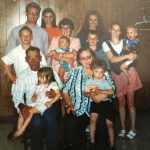
 might have taken her most recent memories away, she always had her favorite pastime…people watching, whether they be in traffic, walking, or on television. My mother-in-law’s Alzheimer’s Disease was the kind that kept the funniest things in life in the forefront of her memory, and she could say the funniest things. While she might not remember our names, she always knew that her children and grandchildren belonged to her, and for that we are forever grateful. Rest in peace Mom, we miss you already, and we love you forever.
might have taken her most recent memories away, she always had her favorite pastime…people watching, whether they be in traffic, walking, or on television. My mother-in-law’s Alzheimer’s Disease was the kind that kept the funniest things in life in the forefront of her memory, and she could say the funniest things. While she might not remember our names, she always knew that her children and grandchildren belonged to her, and for that we are forever grateful. Rest in peace Mom, we miss you already, and we love you forever.
 We have all heard about volcanic eruptions, seen photos or video of one, or maybe even seen one in person. They are an event that makes it hard to take your eyes off of the scene. There are volcanos that erupt often, and there are those that haven’t erupted in hundreds of years. And, there are volcanos that erupt under the ocean. But…there is a rare type of eruption, that is, in fact so rare that it has only been observed twice, although it may have happened elsewhere. It is called a Limnic Eruption.
We have all heard about volcanic eruptions, seen photos or video of one, or maybe even seen one in person. They are an event that makes it hard to take your eyes off of the scene. There are volcanos that erupt often, and there are those that haven’t erupted in hundreds of years. And, there are volcanos that erupt under the ocean. But…there is a rare type of eruption, that is, in fact so rare that it has only been observed twice, although it may have happened elsewhere. It is called a Limnic Eruption.
A limnic eruption, also called a lake overturn, is a rare type of natural disaster in which dissolved carbon dioxide (CO2) gas suddenly erupts from deep lake waters. The eruption forms a gas cloud that can suffocate wildlife, livestock, and humans. It can also cause tsunamis in the lake as the rising CO2 displaces the water. Scientists believe earthquakes, volcanic activity, or explosions can be a trigger for such an explosion. Lakes in which limnic activity occurs are known as limnically active lakes or exploding lakes. Some clues as to limnically active lakes include: CO2 saturated incoming water, a cool lake bottom indicating an absence of direct volcanic interaction with lake waters, an upper and lower thermal layer with differing CO2 saturations, and proximity to areas with volcanic activity, all of which are possible indicators of a limnic lake.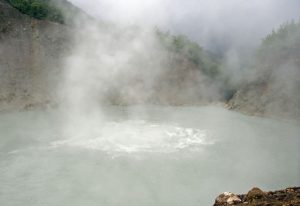
After a Limnic explosion the water left in the lake is filled with debris and massive amounts of dissolved CO2. To date, this phenomenon has been observed only twice. The first was in Cameroon at Lake Monoun in 1984, causing the asphyxiation and death of 38 people living nearby. A second, deadlier eruption happened at neighboring Lake Nyos in 1986, this time releasing over 80 million cubic meters of CO2 and killing around 1,700 people and 3,500 livestock, again by asphyxiation. When the explosion occurred in Lake Nyos, a geyser of water shot out of the lake reaching a height of 300 feet. A small tsunami rushed over the land, followed by a carbon dioxide blast that asphyxiated people up to 15 miles away. Scientists believe limnic explosions are caused by pockets of magma under lakes, which leak and cause carbonic acid to form. In an effort to prevent future explosions, degassing tubes were installed in Lake Nyos to allow the gas to leak at a safe rates.
A third lake, Lake Kivu, on the border between the Democratic Republic of the Congo and Rwanda, also contains massive amounts of dissolved CO2, and it is believed that Limnic eruptions have occurred there too.  Sample sediments from the lake were taken by professor Robert Hecky from the University of Michigan, which showed that an event caused living creatures in the lake to go extinct approximately every thousand years, and caused nearby vegetation to be swept back into the lake. Limnic eruptions can be measured on a scale using the concentration of CO2 in the surrounding area. Due to the nature of the event, it is hard to determine if limnic eruptions have happened elsewhere. The Messel pit fossil deposits of Messel, Germany, also show evidence of a limnic eruption there. Among the victims of that eruption are perfectly preserved insects, frogs, turtles, crocodiles, birds, anteaters, insectivores, early primates and paleotheres.
Sample sediments from the lake were taken by professor Robert Hecky from the University of Michigan, which showed that an event caused living creatures in the lake to go extinct approximately every thousand years, and caused nearby vegetation to be swept back into the lake. Limnic eruptions can be measured on a scale using the concentration of CO2 in the surrounding area. Due to the nature of the event, it is hard to determine if limnic eruptions have happened elsewhere. The Messel pit fossil deposits of Messel, Germany, also show evidence of a limnic eruption there. Among the victims of that eruption are perfectly preserved insects, frogs, turtles, crocodiles, birds, anteaters, insectivores, early primates and paleotheres.
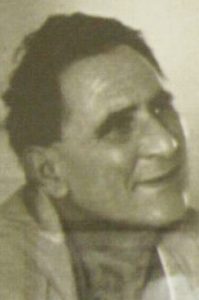 For most of the early years of human history, when a person’s heart gave out…or any other organ, for that matter, it was often the end of that person. Doctors could only do so much, and there are certain body parts that we cannot live without. Of course, these days all that has changed. What used to be considered Frankensteinish, is now a part of modern medicine, and it is saving lives every day. Of course, I don’t think an actual head transplant has ever been done successfully, but many organs are successfully transplanted every day, and every day we hear about some other organ they can transplant…I even read somewhere, and of course, this could be fiction, that they were close to being able to do a brain transplant. I have to admit that the idea of a brain transplant is beyond what I can conceive, but it’s hard to say what is possible…especially when the first heart transplant seemed impossible before December 3, 1967.
For most of the early years of human history, when a person’s heart gave out…or any other organ, for that matter, it was often the end of that person. Doctors could only do so much, and there are certain body parts that we cannot live without. Of course, these days all that has changed. What used to be considered Frankensteinish, is now a part of modern medicine, and it is saving lives every day. Of course, I don’t think an actual head transplant has ever been done successfully, but many organs are successfully transplanted every day, and every day we hear about some other organ they can transplant…I even read somewhere, and of course, this could be fiction, that they were close to being able to do a brain transplant. I have to admit that the idea of a brain transplant is beyond what I can conceive, but it’s hard to say what is possible…especially when the first heart transplant seemed impossible before December 3, 1967.
On that day, 53 year old received the first human heart transplant at Groote Schuur Hospital in Cape Town, South Africa. Washkansky was a South African grocer dying from chronic heart disease. Then, Denise Darvall, a 25 year old woman was fatally injured in a car accident. Surgeon Christiaan Barnard, who had trained at the University of Cape Town and in the United States, performed the revolutionary medical operation. The technique Barnard employed had been initially developed 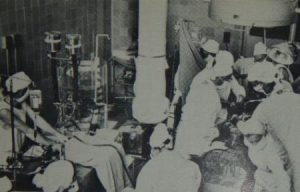 by a group of American researchers in the 1950s. American surgeon Norman Shumway achieved the first successful heart transplant, in a dog, at Stanford University in California in 1958, but prior to that time, transplants were simply a theory.
by a group of American researchers in the 1950s. American surgeon Norman Shumway achieved the first successful heart transplant, in a dog, at Stanford University in California in 1958, but prior to that time, transplants were simply a theory.
A successful heart transplant, or any transplant for that matter, does not necessarily mean a long life after the transplant…unfortunately. After Washkansky’s surgery, he was given drugs to suppress his immune system and keep his body from rejecting the heart. Those drugs worked well, in that Washkansky’s new heart had functioned normally until his death. Nevertheless, these drugs also left him susceptible to sickness, and 18 days later he died from double pneumonia. While losing him was a devastating setback, in the realm of transplants, the operation was an amazing success. Still, a successful transplant was not going to help people to survive, if the anti-rejection medications stifle the immune system and cause the patient to get sick and die 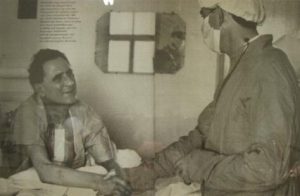 of other illnesses that would have been harmless otherwise.
of other illnesses that would have been harmless otherwise.
In the 1970s, the development of better anti-rejection drugs gave new hope to the transplantation program. Dr. Barnard continued to perform heart transplant operations, and by the late 1970s many of his patients were living up to five years with their new hearts. Successful heart transplant surgery continues to be performed today, but finding appropriate donors is extremely difficult, because the donor must be a match to the patient in blood type and other factors. All too often, the patient waiting for a transplant, dies before a viable donor can found.
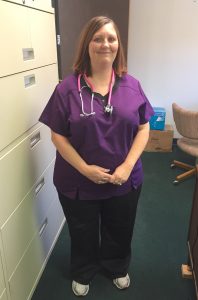 Sometimes, changes occur when we least expect them. That is was happened with my daughter, Corrie Petersen, who found herself in a job that really held no future for her, even after she gave them almost 24 years of her life. Everyone wants to know that they are going to have a chance be promoted and move up in the company, but that was not to be the case, so after listening to the wisdom of God, Corrie made a bold move and went back to school. Corrie has been a caregiver, along with the rest of our family since 2005 when her grandpa, my dad, Allen Spencer got sick. Over the following ten years she was very active in the caregiving process, first with my dad, then my mom, and then her Schulenberg grandparents, and now she cares for her husband, Kevin. I don’t know how we could have managed with out Corrie and others in the family who, just like her, stepped up to pitch in, when we found out that caregiving takes a village.
Sometimes, changes occur when we least expect them. That is was happened with my daughter, Corrie Petersen, who found herself in a job that really held no future for her, even after she gave them almost 24 years of her life. Everyone wants to know that they are going to have a chance be promoted and move up in the company, but that was not to be the case, so after listening to the wisdom of God, Corrie made a bold move and went back to school. Corrie has been a caregiver, along with the rest of our family since 2005 when her grandpa, my dad, Allen Spencer got sick. Over the following ten years she was very active in the caregiving process, first with my dad, then my mom, and then her Schulenberg grandparents, and now she cares for her husband, Kevin. I don’t know how we could have managed with out Corrie and others in the family who, just like her, stepped up to pitch in, when we found out that caregiving takes a village.
When it came to Corrie that if she wanted to move up in a job, she needed a change, 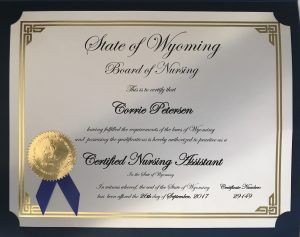 she naturally chose nursing, and began a journey that would bring about many changes and take her to levels of confidence she didn’t know she possessed. She went back to school, after 23 years, and conquered not only the classes, but her own uneasiness about taking them. I am happy to report that she is having great success in her studies. Corrie also took the CNA class at Shepherd of the Valley Care Center, knowing that when she started nursing school, she would no longer be able to keep the job she had, because the nursing program is held during the day. She passed the CNA program with flying colors and applied for a job at Elkhorn Valley Rehabilitation Hospital. She was hired right away, and today begins her new career as a CNA, or according to them, Patient Care Technician…temporarily anyway, because Corrie’s journey doesn’t end there. She has other plans in mind.
she naturally chose nursing, and began a journey that would bring about many changes and take her to levels of confidence she didn’t know she possessed. She went back to school, after 23 years, and conquered not only the classes, but her own uneasiness about taking them. I am happy to report that she is having great success in her studies. Corrie also took the CNA class at Shepherd of the Valley Care Center, knowing that when she started nursing school, she would no longer be able to keep the job she had, because the nursing program is held during the day. She passed the CNA program with flying colors and applied for a job at Elkhorn Valley Rehabilitation Hospital. She was hired right away, and today begins her new career as a CNA, or according to them, Patient Care Technician…temporarily anyway, because Corrie’s journey doesn’t end there. She has other plans in mind.

She will have other new beginnings as she continues her journey toward her degree as a Registered Nurse, so this is temporary, but it is nevertheless, very exciting. This is what she has dreamed about since this journey started. She knows the work will be hard, but it is also very rewarding as she also knows, since she has basically been doing this work for twelve years already. I am so excited for my daughter, as she starts this new adventure, and so proud of her for taking the necessary steps to achieve her goals. The future is going to be a bright one for her, and I can’t wait to watch the changes as she decides her future plans in her nursing career. Congratulations Corrie. Have a wonderful first night at work. We are so proud of you!!

